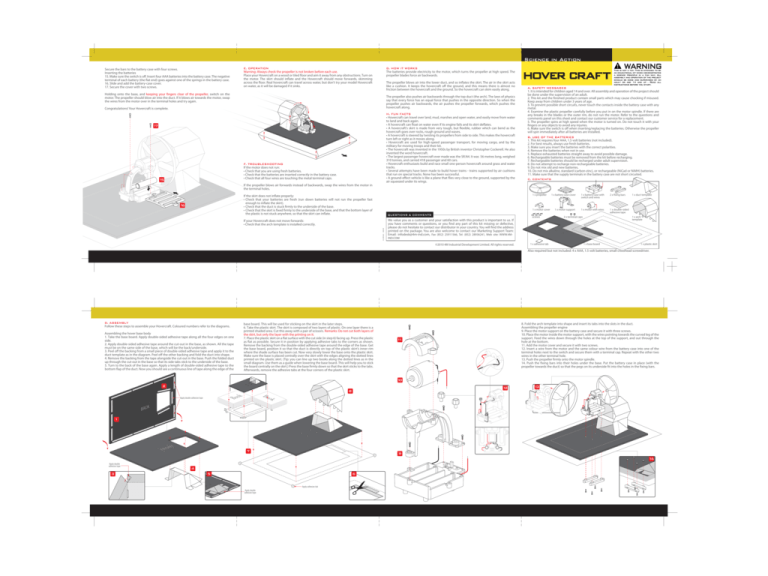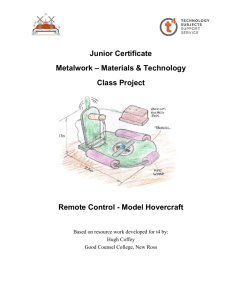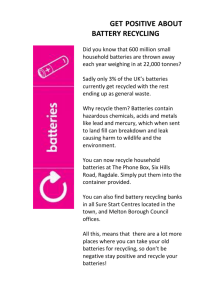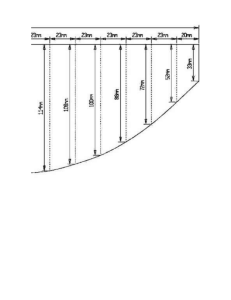
Science in Action
Secure the bars to the battery case with four screws.
Inserting the batteries
15. Make sure the switch is off. Insert four AAA batteries into the battery case. The negative
terminal of each battery (the flat end) goes against one of the springs in the battery case.
16. Slide and add the battery-case cover.
17. Secure the cover with two screws.
E. OPERATION
Warning: Always check the propeller is not broken before each use.
Place your Hovercraft on a wood or tiled floor and aim it away from any obstructions. Turn on
the motor. The skirt should inflate and the Hovercraft should move forwards, skimming
across the floor. Real hovercraft can travel across water, but don't try your model Hovercraft
on water, as it will be damaged if it sinks.
G. HOW IT WORKS
The batteries provide electricity to the motor, which turns the propeller at high speed. The
propeller blades force air backwards.
The propeller blows air into the lower duct, and so inflates the skirt. The air in the skirt acts
like a cushion. It keeps the hovercraft off the ground, and this means there is almost no
friction between the hovercraft and the ground. So the hovercraft can skim easily along.
Holding onto the base, and keeping your fingers clear of the propeller, switch on the
motor. The propeller should blow air into the duct. If it blows air towards the motor, swap
the wires from the motor over in the terminal holes and try again.
The propeller also pushes air backwards through the top duct (the arch). The laws of physics
say that every force has an equal force that pushes in the opposite direction. So when the
propeller pushes air backwards, the air pushes the propeller forwards, which pushes the
hovercraft along.
Congratulations! Your Hovercraft is complete.
H. FUN FACTS
• Hovercraft can travel over land, mud, marshes and open water, and easily move from water
to land and back again.
• A hovercraft can float on water even if its engine fails and its skirt deflates.
• A hovercraft's skirt is made from very tough, but flexible, rubber which can bend as the
hovercraft goes over rocks, rough ground and waves.
• A hovercraft is steered by twisting its propellers from side to side. This makes the hovercraft
turn left or right as it moves along.
• Hovercraft are used for high-speed passenger transport, for moving cargo, and by the
military for moving troops and their kit.
• The hovercraft was invented in the 1950s by British inventor Christopher Cockerell. He also
invented the word hovercraft.
• The largest passenger hovercraft ever made was the SR.N4. It was 56 metres long, weighed
310 tonnes, and carried 418 passenger and 60 cars.
• Hovercraft enthusiasts build and race small one-person hovercraft around grass and water
tracks.
• Several attempts have been made to build hover trains - trains supported by air cushions
that run on special tracks. None has been successful.
• A ground-effect vehicle is like a plane that flies very close to the ground, supported by the
air squeezed under its wings.
17
F. TROUBLESHOOTING
If the motor does not run:
• Check that you are using fresh batteries.
• Check that the batteries are inserted correctly in the battery case.
• Check that all four wires are touching the metal terminal caps.
15
If the propeller blows air forwards instead of backwards, swap the wires from the motor in
the terminal holes.
A. SAFETY MESSAGES
1. It is intended for children aged 14 and over. All assembly and operation of the project should
be done under the supervision of an adult.
2. This kit and the finished product contain small parts which may cause chocking if misused.
Keep away from children under 3 years of age.
3. To prevent possible short circuits, never touch the contacts inside the battery case with any
metal.
4. Examine the plastic propeller carefully before you put in on the motor spindle. If there are
any breaks in the blades or the outer rim, do not run the motor. Refer to the questions and
comments panel on this sheet and contact our customer service for a replacement.
5. The propeller spins at high speed when the motor is turned on. Do not touch it with your
fingers or any objects to avoid any injuries.
6. Make sure the switch is off when inserting/replacing the batteries. Otherwise the propeller
will spin immediately after all batteries are installed.
B. USE OF THE BATTERIES
1. This kit requires four AAA, 1.5 volt batteries (not included).
2. For best results, always use fresh batteries.
3. Make sure you insert the batteries with the correct polarities.
4. Remove the batteries when not in use.
5. Replace exhausted batteries straight away to avoid possible damage.
6. Rechargeable batteries must be removed from the kit before recharging.
7. Rechargeable batteries should be recharged under adult supervision.
8. Do not attempt to recharge non-rechargeable batteries.
9. Do not mix old and new batteries.
10. Do not mix alkaline, standard (carbon-zinc), or rechargeable (NiCad or NiMH) batteries.
11. Make sure that the supply terminals in the battery case are not short circuited.
C. CONTENTS
1 x propeller
If the skirt does not inflate properly:
• Check that your batteries are fresh (run down batteries will not run the propeller fast
enough to inflate the skirt).
• Check that the duct is stuck firmly to the underside of the base.
• Check that the skirt is fixed firmly to the underside of the base, and that the bottom layer of
the plastic is not stuck anywhere, so that the skirt can inflate.
16
HOVER CRAFT
1 x motor cover
QUESTIONS & COMMENTS
41-03910/1 100319
If your Hovercraft does not move forwards:
• Check that the arch template is installed correctly.
We value you as a customer and your satisfaction with this product is important to us. If
you have comments or questions, or you find any part of this kit missing or defective,
please do not hesitate to contact our distributor in your country. You will find the address
printed on the package. You are also welcome to contact our Marketing Support Team:
Email: infodesk@4m-ind.com, Fax (852) 25911566, Tel: (852) 28936241, Web site: WWW.4M-
This is not a toy. This is intended to be
an educational kit which demonstrates
a science principle in a fun way. All
assembly and operation of the project
should be done and supervised by an
adult or age 14 and up . Read all
instructions before you start.
screws
1 x battery case cover
1 x battery case with
switch and wires
2 x fixing bars
1 x motor support
1 x motor with wires
1 x double-sided
adhesive tape
2 x terminal caps
1 x duct template
1 x arch
template
IND.COM
©2010 4M Industrial Development Limited. All rights reserved.
1 x adhesive tab
1 x base board
1 x plastic skirt
Also required but not included: 4 x AAA, 1.5 volt batteries, small crosshead screwdriver.
D. ASSEMBLY
Follow these steps to assemble your Hovercraft. Coloured numbers refer to the diagrams.
Assembling the hover base body
1. Take the base board. Apply double-sided adhesive tape along all the four edges on one
side.
2. Apply double-sided adhesive tape around the cut-out in the base, as shown. All the tape
must be on the same side of the base, which will be the back/underside.
3. Peel off the backing from a small piece of double-sided adhesive tape and apply it to the
duct template as in the diagram. Peel off the other backing and fold the duct into shape.
4. Remove the backing from the tape alongside the cut-out in the base. Push the folded duct
up through the cut-out in the base so that its side tabs stick to the underside of the base.
5. Turn to the back of the base again. Apply a length of double-sided adhesive tape to the
bottom flap of the duct. Now you should see a continuous line of tape along the edge of the
base board. This will be used for sticking on the skirt in the later steps.
6. Take the plastic skirt. The skirt is composed of two layers of plastic. On one layer there is a
printed shaded area. Cut this away with a pair of scissors. Remarks: Do not cut both layers of
the skirt, but only the layer with the printing on it.
7. Place the plastic skirt on a flat surface with the cut side (in step 6) facing up. Press the plastic
as flat as possible. Secure it in position by applying adhesive tabs to the corners as shown.
Remove the backing from the double-sided adhesive tape around the edge of the base. Get
the base board, position it so that the duct is directly on top of the plastic skirt’s inner rim
where the shade surface has been cut. Now very slowly lower the base onto the plastic skirt.
Make sure the base is placed centrally over the skirt with the edges aligning the dotted lines
printed on the plastic skirt. (Tip: you can line up two books along the dotted lines as in the
small diagram. Use them as a guide when lowering the base board. This will help you to stick
the board centrally on the skirt.) Press the base firmly down so that the skirt sticks to the tabs.
Afterwards, remove the adhesive tabs at the four corners of the plastic skirt.
8. Fold the arch template into shape and insert its tabs into the slots in the duct.
Assembling the propeller engine
9. Place the motor support on the battery case and secure it with three screws.
10. Place the motor inside the motor support, with the wires pointing towards the curved leg of the
support. Feed the wires down through the holes at the top of the support, and out through the
hole at the bottom.
11. Add the motor cover and secure it with two screws.
12. Insert a wire from the motor and the same colour wire from the battery case into one of the
terminal holes next to the switch and secure them with a terminal cap. Repeat with the other two
wires in the other terminal hole.
13. Push the propeller firmly onto the motor spindle.
14. Push the fixing bars into their holes under the base. Put the battery case in place (with the
propeller towards the duct) so that the pegs on its underside fit into the holes in the fixing bars.
11
10
2
12
8
13
Apply double adhesive tape
K
BAC
1
NT
FRO
7
9
14
Apply double
adhesive tape
3
4
5
6
Apply adhesive tab
Apply double
adhesive tape
Science in Action
Secure the bars to the battery case with four screws.
Inserting the batteries
15. Make sure the switch is off. Insert four AAA batteries into the battery case. The negative
terminal of each battery (the flat end) goes against one of the springs in the battery case.
16. Slide and add the battery-case cover.
17. Secure the cover with two screws.
E. OPERATION
Warning: Always check the propeller is not broken before each use.
Place your Hovercraft on a wood or tiled floor and aim it away from any obstructions. Turn on
the motor. The skirt should inflate and the Hovercraft should move forwards, skimming
across the floor. Real hovercraft can travel across water, but don't try your model Hovercraft
on water, as it will be damaged if it sinks.
G. HOW IT WORKS
The batteries provide electricity to the motor, which turns the propeller at high speed. The
propeller blades force air backwards.
The propeller blows air into the lower duct, and so inflates the skirt. The air in the skirt acts
like a cushion. It keeps the hovercraft off the ground, and this means there is almost no
friction between the hovercraft and the ground. So the hovercraft can skim easily along.
Holding onto the base, and keeping your fingers clear of the propeller, switch on the
motor. The propeller should blow air into the duct. If it blows air towards the motor, swap
the wires from the motor over in the terminal holes and try again.
The propeller also pushes air backwards through the top duct (the arch). The laws of physics
say that every force has an equal force that pushes in the opposite direction. So when the
propeller pushes air backwards, the air pushes the propeller forwards, which pushes the
hovercraft along.
Congratulations! Your Hovercraft is complete.
H. FUN FACTS
• Hovercraft can travel over land, mud, marshes and open water, and easily move from water
to land and back again.
• A hovercraft can float on water even if its engine fails and its skirt deflates.
• A hovercraft's skirt is made from very tough, but flexible, rubber which can bend as the
hovercraft goes over rocks, rough ground and waves.
• A hovercraft is steered by twisting its propellers from side to side. This makes the hovercraft
turn left or right as it moves along.
• Hovercraft are used for high-speed passenger transport, for moving cargo, and by the
military for moving troops and their kit.
• The hovercraft was invented in the 1950s by British inventor Christopher Cockerell. He also
invented the word hovercraft.
• The largest passenger hovercraft ever made was the SR.N4. It was 56 metres long, weighed
310 tonnes, and carried 418 passenger and 60 cars.
• Hovercraft enthusiasts build and race small one-person hovercraft around grass and water
tracks.
• Several attempts have been made to build hover trains - trains supported by air cushions
that run on special tracks. None has been successful.
• A ground-effect vehicle is like a plane that flies very close to the ground, supported by the
air squeezed under its wings.
17
F. TROUBLESHOOTING
If the motor does not run:
• Check that you are using fresh batteries.
• Check that the batteries are inserted correctly in the battery case.
• Check that all four wires are touching the metal terminal caps.
15
If the propeller blows air forwards instead of backwards, swap the wires from the motor in
the terminal holes.
A. SAFETY MESSAGES
1. It is intended for children aged 14 and over. All assembly and operation of the project should
be done under the supervision of an adult.
2. This kit and the finished product contain small parts which may cause chocking if misused.
Keep away from children under 3 years of age.
3. To prevent possible short circuits, never touch the contacts inside the battery case with any
metal.
4. Examine the plastic propeller carefully before you put in on the motor spindle. If there are
any breaks in the blades or the outer rim, do not run the motor. Refer to the questions and
comments panel on this sheet and contact our customer service for a replacement.
5. The propeller spins at high speed when the motor is turned on. Do not touch it with your
fingers or any objects to avoid any injuries.
6. Make sure the switch is off when inserting/replacing the batteries. Otherwise the propeller
will spin immediately after all batteries are installed.
B. USE OF THE BATTERIES
1. This kit requires four AAA, 1.5 volt batteries (not included).
2. For best results, always use fresh batteries.
3. Make sure you insert the batteries with the correct polarities.
4. Remove the batteries when not in use.
5. Replace exhausted batteries straight away to avoid possible damage.
6. Rechargeable batteries must be removed from the kit before recharging.
7. Rechargeable batteries should be recharged under adult supervision.
8. Do not attempt to recharge non-rechargeable batteries.
9. Do not mix old and new batteries.
10. Do not mix alkaline, standard (carbon-zinc), or rechargeable (NiCad or NiMH) batteries.
11. Make sure that the supply terminals in the battery case are not short circuited.
C. CONTENTS
1 x propeller
If the skirt does not inflate properly:
• Check that your batteries are fresh (run down batteries will not run the propeller fast
enough to inflate the skirt).
• Check that the duct is stuck firmly to the underside of the base.
• Check that the skirt is fixed firmly to the underside of the base, and that the bottom layer of
the plastic is not stuck anywhere, so that the skirt can inflate.
16
HOVER CRAFT
1 x motor cover
QUESTIONS & COMMENTS
41-03910/1 100319
If your Hovercraft does not move forwards:
• Check that the arch template is installed correctly.
We value you as a customer and your satisfaction with this product is important to us. If
you have comments or questions, or you find any part of this kit missing or defective,
please do not hesitate to contact our distributor in your country. You will find the address
printed on the package. You are also welcome to contact our Marketing Support Team:
Email: infodesk@4m-ind.com, Fax (852) 25911566, Tel: (852) 28936241, Web site: WWW.4M-
This is not a toy. This is intended to be
an educational kit which demonstrates
a science principle in a fun way. All
assembly and operation of the project
should be done and supervised by an
adult or age 14 and up . Read all
instructions before you start.
screws
1 x battery case cover
1 x battery case with
switch and wires
2 x fixing bars
1 x motor support
1 x motor with wires
1 x double-sided
adhesive tape
2 x terminal caps
1 x duct template
1 x arch
template
IND.COM
©2010 4M Industrial Development Limited. All rights reserved.
1 x adhesive tab
1 x base board
1 x plastic skirt
Also required but not included: 4 x AAA, 1.5 volt batteries, small crosshead screwdriver.
D. ASSEMBLY
Follow these steps to assemble your Hovercraft. Coloured numbers refer to the diagrams.
Assembling the hover base body
1. Take the base board. Apply double-sided adhesive tape along all the four edges on one
side.
2. Apply double-sided adhesive tape around the cut-out in the base, as shown. All the tape
must be on the same side of the base, which will be the back/underside.
3. Peel off the backing from a small piece of double-sided adhesive tape and apply it to the
duct template as in the diagram. Peel off the other backing and fold the duct into shape.
4. Remove the backing from the tape alongside the cut-out in the base. Push the folded duct
up through the cut-out in the base so that its side tabs stick to the underside of the base.
5. Turn to the back of the base again. Apply a length of double-sided adhesive tape to the
bottom flap of the duct. Now you should see a continuous line of tape along the edge of the
base board. This will be used for sticking on the skirt in the later steps.
6. Take the plastic skirt. The skirt is composed of two layers of plastic. On one layer there is a
printed shaded area. Cut this away with a pair of scissors. Remarks: Do not cut both layers of
the skirt, but only the layer with the printing on it.
7. Place the plastic skirt on a flat surface with the cut side (in step 6) facing up. Press the plastic
as flat as possible. Secure it in position by applying adhesive tabs to the corners as shown.
Remove the backing from the double-sided adhesive tape around the edge of the base. Get
the base board, position it so that the duct is directly on top of the plastic skirt’s inner rim
where the shade surface has been cut. Now very slowly lower the base onto the plastic skirt.
Make sure the base is placed centrally over the skirt with the edges aligning the dotted lines
printed on the plastic skirt. (Tip: you can line up two books along the dotted lines as in the
small diagram. Use them as a guide when lowering the base board. This will help you to stick
the board centrally on the skirt.) Press the base firmly down so that the skirt sticks to the tabs.
Afterwards, remove the adhesive tabs at the four corners of the plastic skirt.
8. Fold the arch template into shape and insert its tabs into the slots in the duct.
Assembling the propeller engine
9. Place the motor support on the battery case and secure it with three screws.
10. Place the motor inside the motor support, with the wires pointing towards the curved leg of the
support. Feed the wires down through the holes at the top of the support, and out through the
hole at the bottom.
11. Add the motor cover and secure it with two screws.
12. Insert a wire from the motor and the same colour wire from the battery case into one of the
terminal holes next to the switch and secure them with a terminal cap. Repeat with the other two
wires in the other terminal hole.
13. Push the propeller firmly onto the motor spindle.
14. Push the fixing bars into their holes under the base. Put the battery case in place (with the
propeller towards the duct) so that the pegs on its underside fit into the holes in the fixing bars.
11
10
2
12
8
13
Apply double adhesive tape
K
BAC
1
NT
FRO
7
9
14
Apply double
adhesive tape
3
4
5
6
Apply adhesive tab
Apply double
adhesive tape








